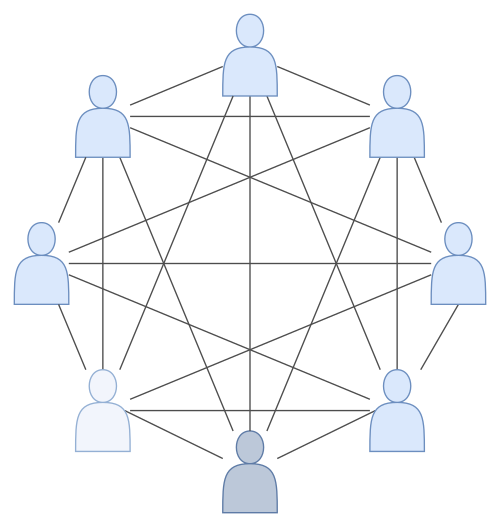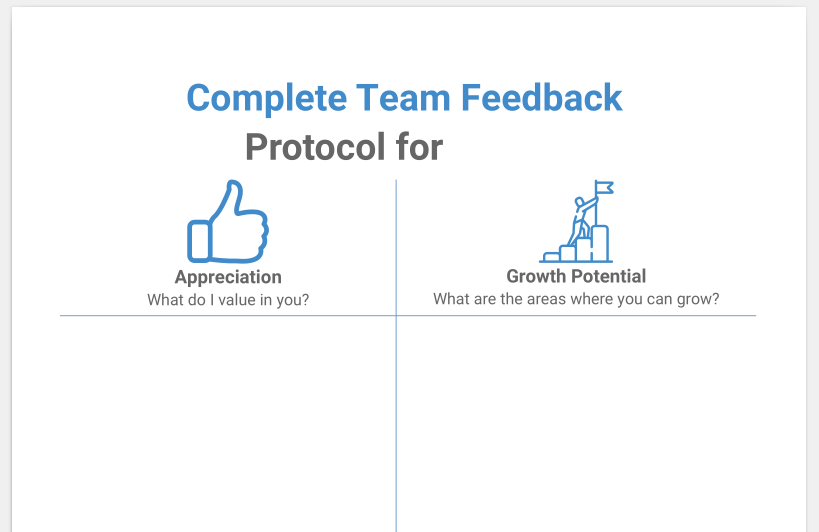Improving Feedback Flows in Organizations with 'Complete Peer Feedback'
Posted on Feb 5, 2020. Updated on Feb 6, 2023
Traditional hierarchy-based feedback flows are limited as they don’t consider the useful feedback of peers. To improve this, I suggest a “Complete Peer Feedback” session: All team members come together and share their appreciation and growth potential for their peers. In this post, I present our experiences with this approach, why we are enthusiastic about it and how you can adopt it.

The Problem
Feedback is only given along the hierarchies.
Unfortunately, in many organizations, feedback is only given along the hierarchies. In staff appraisals, the team manager talks to the team member and both exchange feedback. What’s wrong with this approach?
- It’s not planned that one team member gives feedback to its peers. So in a team of seven persons, you only receive feedback from one person, the team manager, although the other six peers could also (and most likely even better) assess their performance.
- Even worse, in some organizations, the feedback flow is only a one-way road where only the superior gives feedback to the team member without asking for feedback for themselves.
- A cross-functional team often consists of employees of different professions. For instance, in software development, there is also a product owner and an UI designer next to the developers. But often, they report to another manager which is not part of the feature team. Hence, they are not able to give and receive feedback properly, which is sad as they spend most of their time in this team.
The Idea
In a Complete Peer Feedback session, every team member gives feedback to each peer.
So let’s forget hierarchies and try something better. We call our approach “Complete Peer Feedback”: First, we let the whole team come together in a cozy and open atmosphere. Therefore, having a circle of chairs is a good idea. Second, we stick to the following process: You start with one team member. Now, each remaining peer addresses the following two questions in their turn:
- Appreciation: What do I value in you?
- Growth Potential: What are the areas where you can grow?
After the last team member has given their feedback, you move on to the next team member.
An important aspect of the meeting is the protocol. One participant writes a protocol containing the mentioned appreciation and growth potential for each team member. After the meeting, the protocol is formally handed over to them.

Template for the Protocol that is written during the Complete Peer Feedback session
The PDF for the protocol can be found in the ‘Getting Started’ section below.
After the meeting, every team member formally receives the protocol with their appreciation and growth potential.
As a follow-up, the protocol can be used as a valuable input for a subsequent 1-on-1 meeting with the team manager. In this meeting, both can reflect on the received feedback and come up with an action plan.
The Briefing and the Feedback Rules
To make this meeting successful, a briefing is essential. Otherwise, you may end up with endless disputes, hurt feelings, insults or broken interpersonal relationships. My briefing looked like this:
- First of all, thanks for giving this experiment a chance.
- Please prepare the meeting carefully.
- Answer the following two questions for each team member:
- What do I value in you? (Appreciation)
- What are the areas where you can grow? (Growth Potential)
- It’s okay to have none or even multiple points for each question.
- Please make it short.
- I will write a small protocol that will be formally handed over to you after the meeting.
- Important: This meeting is not for shaming. It’s primarily about appreciation. Everyone does a good job every day and we should tell them. Besides, you can point out aspects which can be improved by your peer. Therefore, refer to one’s future, not the past.
- Follow the rules for giving and receiving feedback.
- For the feedback sender, it’s crucial to phrase the feedback in a certain way:
- Use I-messages instead of you-messages.
- You can phrase your feedback following the Observation-Impact-Request/Wish pattern.
- Talk about the behavior of a person, not their traits.
- Avoid generic statements and try to refer to a concrete situation and behavior.
- For the feedback receiver, an open, thankful, and humble mindset is essential:
- Listen carefully. Don’t start a “Yes, but…"-discussion. You don’t need to respond directly to the feedback even if you disagree. Take your time to reflect on the feedback and why your peers might have given it to you.
- Be thankful for the opportunity to grow.
- Nobody is perfect and everybody makes mistakes. Everyone can improve and grow.
- The feedback sender is well-disposed to you and wants you to grow.
- For the feedback sender, it’s crucial to phrase the feedback in a certain way:
Our Findings
In our team, we tried this feedback approach. Our most important findings are:
- Huge amount and diversity of feedback. In the old hierarchy-based feedback flow, a team member only received feedback from one person, the team manager. Now, they receive feedback from all peers (seven in our team). This also ensures a better diversity of feedback as different opinions are covered.
- Uplifting feeling! We did the meeting on a Friday and during the whole weekend, I was delighted and inspired in the face of all the appreciation that I had received. My team members reported the same great feelings they had after this meeting.
- Great team-building. Afterward, the team felt that the meeting had a great team-building impact. First, we got to know each other much better. Second, each team member becomes aware of many aspects that their peers value in them. This had a positive impact on interpersonal relationships. Third, sharing this joint experience brought the team closer together and promoted the team spirit.
- Self-perception vs perception by others (surprises!). The Complete Peer Feedback reveals mismatches between one’s self-perception and the perception by others. For instance, one team member was surprised that their development skills were valued with so much emphasis. Another one excepted that certain behavior would be criticized which was not the case. So apparently, this behavior is no problem at all.
- Motivation. I strongly believe in the motivating power of appreciation. The lack of praise can lead to demotivated employees, which don’t perform well or even resign.
- Useful growth potential. Before the meeting, some team members were afraid of flattering without any useful feedback. Like we would only hold our hands while singing “Kumbaya My Lord”. They were very happy that they received constructive feedback to improve and grow.
- Uncover misunderstandings. We straightened out misunderstandings. For example: “Sometimes, you look angry when I’m talking to you” - “Oh sorry, that’s just my thinking face. Please don’t take it personally.” - “Oh, I see. Good that we talked about it”. That dialog might sound trivial, but it’s very important. Without this feedback meeting, they would never be aware of this misunderstanding.
- Reveal relationships between others. You get an impression of the relationship between two members based on the feedback they give each other. Moreover, especially in bigger teams, you often have duos or small subgroups working closely together. It’s very interesting to see how those team members give feedback to each other.
- Useful input for the 1-on-1 with team manager. For a team manager, the created protocol is very valuable as you now have many different opinions about a team member. You don’t have to rely only on your own opinion, you can get new perspectives about a team member and you can be more objective in your assessment.
Other findings are:
- After the meeting, we felt that having a Complete Peer Feedback once a year is enough.
- Our team has 8 members (6 devs, 1 PO, 1 team lead). It took us 2.5 h which already includes a short introduction and a closing reflection about the meeting. The point is that the required time increases non-linear with the number of team members. So it’s not that scalable.
- As a room, you can book a meeting that is big enough for your team. However, I suggest creating a more cozy and open atmosphere. For instance, we rearrange the couches in our office to a circle. But you can do the same with chairs.
A Success at Spreadshirt
I presented the Complete Peer Feedback approach to other team managers at Spreadshirt. As of today, it was adopted by many other teams. They were all satisfied with this approach and gave positive feedback to me.
Getting Started
- Send your team the above briefing and schedule the meeting.
- Give them time to prepare.
- Download the template for the protocol: PDF or LibreOffice ODT.
Variation: Face-to-Face Vs Sticky Notes
There are many introverts in our software industry, which is great. However, some introverts may have trouble with speaking up and dare to give negative feedback directly into one’s face. In this case, you can consider a variation: Let all team members write down their feedback on sticky notes. Next, all notes are collected and presented by a neutral person. So nobody knows which feedback comes from which person.
Sticky notes may also be a good strategy if the team members fear negative consequences for their career if they give honest feedback to the team manager.
However, we decided against this anonymous approach. We experienced that messages on the sticky notes tend to be unclear on what exactly was meant. The missing context and framing may lead to misunderstandings. Moreover, we also learn less about our team in terms of opinions and relationships.
Further Reading and Contribution
- Frederic Laloux: Reinventing Organizations (Illustrated)
. This great book introduced the idea of a team-based feedback session which inspired me to try the above approach. The book’s wiki contains some information about “Feedback and Performance Management”. I started with the presented approach that is used in the company ‘Sounds True’ but removed some ceremony and boiled it down to the idea of a meeting where team members are giving feedback to each other.
- My post “Code Review Guidelines for Humans” contains many generic feedback rules which are useful for the Complete Peer Feedback session.
Trivia
We call the session Complete Peer Feedback because, in graph theory, a complete graph is a graph where all nodes are connected with an edge - just like all team members are connected with feedback.